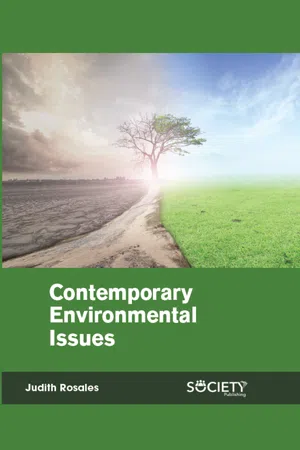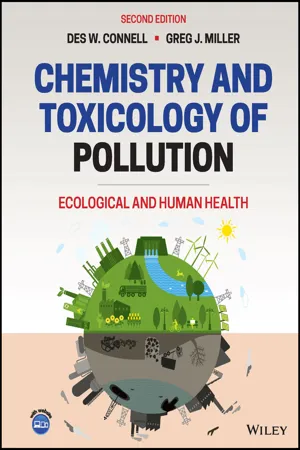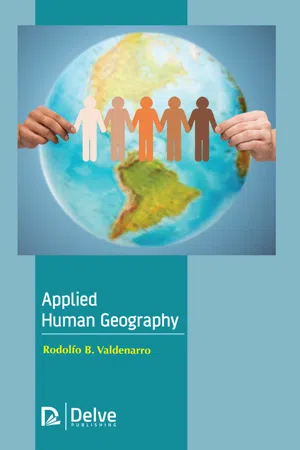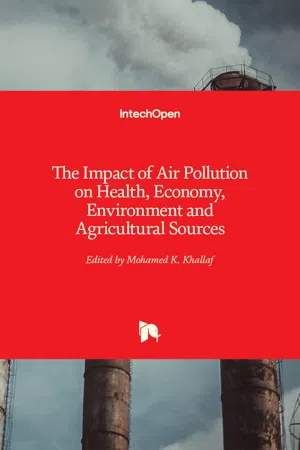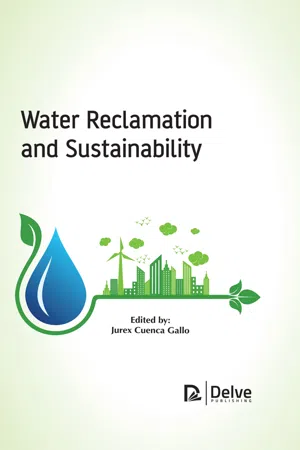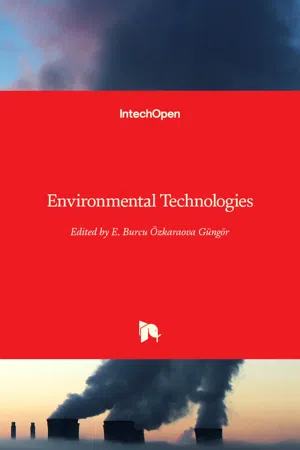Geography
Environmental Pollution
Environmental pollution refers to the introduction of harmful contaminants into the natural environment, causing adverse effects on ecosystems, human health, and the planet as a whole. This can include air, water, and soil pollution, as well as noise and light pollution. Human activities such as industrial processes, transportation, and waste disposal are major contributors to environmental pollution.
Written by Perlego with AI-assistance
Related key terms
1 of 5
10 Key excerpts on "Environmental Pollution"
- eBook - PDF
- Judith Rosales(Author)
- 2019(Publication Date)
- Society Publishing(Publisher)
POLLUTION: A MAJOR ENVIRONMENTAL ISSUE Chapter 2 LEARNING OBJECTIVES: In this chapter, you will learn about: • Pollution and its types. • The science of pollution. • Major causes of Environmental Pollution. • Status of Environmental Pollution in developing nations. • Environmental impacts of pollution. Key Terms: • Acid rain • Air pollution • Carbon monoxide • Electromagnetic pollution • Neuromuscular blockage • Pollution • Radioactive • Soil pollution • Water pollution Contemporary Environmental Issues 26 2.1. INTRODUCTION Environmental Pollution is defined as the contamination of the physical and biological components of the earth or atmosphere system to such an extent that normal environmental processes are adversely affected. Environmental Pollution is one of the most serious problems facing humanity and other life forms on our planet today. Not every pollutant is harmful and endangers human life, but pollutants that are said to be contaminated are those that are in excess of natural levels. Any use of natural resources at a rate higher than nature’s capacity to restore itself can result in pollution of air, water, and land. There has been increasing global concern over the public health impacts attributed to Environmental Pollution, in particular, the global burden of disease. The World Health Organization (WHO) estimates that about a quarter of the diseases facing mankind today occur due to prolonged exposure to Environmental Pollution and its increasing levels. Pollution is the adulteration of the environment by the introduction of contaminants that can cause damage to the environment and harm or discomfort to humans or other living species. It is the accumulation of another form of any substance or form of energy to the environment at a rate faster than the environment that can accommodate it by scattering, cessation, reprocessing, or loading in some meaningless form. - eBook - PDF
- Marcel van der Perk(Author)
- 2017(Publication Date)
- CRC Press(Publisher)
In fact, the most widespread Environmental Pollution involves ‘natural’ compounds (for example, carbon dioxide) and fertilisers (such as nitrate). Furthermore, pollution is not restricted to substances, but can also refer to energy wastes, such as heat, light, and noise. In all cases, pollution alters the chemical, physical, biological, or radiological integrity of soil and water by killing species or changing their growth rate, interfering with food chains, or adversely affecting human health and well-being. Note that some experts distinguish between pollution and contamination. They use the term contamination for situations where a pollutant is present in the environment, but not causing any harm, while they use the term pollution for situations where harmful effects are apparent (see Alloway and Ayres, 1997). However, the distinction between contamination and pollution may not be clear, because harmful effects may be present but unobserved. The above definition of pollution and contamination avoids this problem, so in this book the two terms are used interchangeably. Human activity is unevenly distributed over the world; the Earth’s surface, too, is variable by nature. As a result, the intensity and consequences of Environmental Pollution vary from place to place. Of the 136 million km 2 land surface on Earth, about 10 percent is used as arable land and 25 percent consists of productive pasture and of forests that might be converted into agricultural land. The pursuit of ever-higher agricultural yields, which has been made possible through technological innovation and the cultivation of marginal areas, has resulted in widespread degradation of agricultural land. In the past half-century, 40 percent of the world’s agricultural land has been degraded by accelerated erosion by wind and water, salinisation, compaction, nutrient exhaustion, pollution, and urbanisation (Millennium Ecosystem Assessment, 2003). - eBook - PDF
Chemistry and Toxicology of Pollution
Ecological and Human Health
- Des W. Connell, Gregory J. Miller(Authors)
- 2022(Publication Date)
- Wiley(Publisher)
41 3 Pollutants, Health, and Environment 3.1 Introduction This chapter introduces the threats and impacts of pol- lution on human health, ecological health, and the environment, as measured by the burden of disease in humans and the loss of biodiversity and ecosystem ser- vices. Understanding the links between human activities, concepts of health, and ecosystems is essential for solving current and future pollution-related issues. The global challenge to meet United Nations Sustainable Develop- ment Goals that are affected by pollution and other human activities has become critical (see Landrigan et al. 2017). The environmental state of the Earth is under seri- ous threat. The Report of the Sixth Global Environment Outlook (GEO 6) (UNEP 2019) found that the overall condition of the global environment has continued to deteriorate since 1997 (GEO First edition), despite envi- ronmental policy efforts worldwide. Between 1970 and 2014, population abundances of global vertebrate species have decreased by on average 60%. The GEO 6 report concludes that unsustainable human activities globally have degraded the Earth’s ecosystems, endangering the ecological foundations of society. Here, we introduce concepts of health and theories of disease causation, and their progression from environmen- tal to planetary health, and the role of human activities and pollution in its impacts and threats to human health and ecological health. This information forms the contextual basis for the scientific evaluation of pollution, pollutants, and their toxic effects in the following chapters. 3.2 Environmental Health Concept of Health What is health? Human health is basically seen as a per- son’s physical or mental state or condition rather than an absence of disease. It can be viewed as a dynamic condition that results from a body’s constant adaptation in response to stress and changes (e.g. environmental) to maintain an internal equilibrium condition, known as homeostasis. - eBook - PDF
- Rodolfo B. Valdenarro(Author)
- 2019(Publication Date)
- Delve Publishing(Publisher)
The Impact of Human on Environmental Geographies 10 CONTENTS 10.1. Introduction .................................................................................. 204 10.1. Environmentalism ......................................................................... 207 10.2. Nature Of Environmental Geography ............................................ 209 10.3. Human-Environment Relationships In Modern And Postmodern Geography ................................................................ 212 10.4. The Nature–Society Dichotomy ..................................................... 218 10.5. Geographic Information Systems And Environmental Health ........ 220 Applied Human Geography 204 Rampant industrialization and advancements in technology has caused significant threats to the environment. Environmental geography is concerned with the spatial aspects of interactions between humans and the natural world. The chapter begins with a discussion of environmentalism. It then describes the various aspects of environmental geography. The impact of humans on environment can be traced to the day when the first man arrived. This chapter discusses how humans and environment is linked in the modern day. The chapter also highlights how there is strong divide between nature and society. Finally, the chapter discusses geographic information system and environmental health. 10.1. INTRODUCTION Geography is the field of science devoted to the study of the lands, features, inhabitants, and phenomena of the Earth and planets. The word geography is derived from the Greek word geographia , which means “earth description” The field of geography encompasses multiple disciplines to understand the Earth and its human and natural complexities. - eBook - PDF
- Dhankhar, Rajesh(Authors)
- 2021(Publication Date)
- Daya Publishing House(Publisher)
A Environmental Pollution Definition Types of Pollution Disaster Management Definition ny change in the physical, chemical and biological characteristics of air, water and soil that affect the health or activities of human beings or other forms of life in an undesirable manner is the result of pollution. Pollution not only causes physical harm but also psychological distress, foul odours, unpleasant sights, noise, heat etc. In other words, pollution is a direct or indirect change in any component of the biosphere that is harmful to the living components. This ebook is exclusively for this university only. Cannot be resold/distributed. Pollution is caused by pollutants. Some of the main pollutants are gases, metals, deposited matter, poison, sewage water, fertilisers, radioactive substances, heat and noise. These pollutants are of two types–biodegradable pollutants and non-biodegradable pollutants. The substances that decompose slowly in the natural environment are known as non biodegradable whereas those substances that can decompose naturally in the environment are known as biodegradable, such as sewage waste. The sewage wastes are rapidly decomposed by natural processes. Non biodegradable substances accumulate along the food chain and became biologically magnified. Types of Pollution Pollution is of two types: Natural pollution: Pollution that originates from natural processes. Artificial pollution: Pollution that originates from the activities of man. Air Pollution When the concentration of normal component of air or some chemical added, or formed in the air upto the point of causing harm to the living organisms or to materials. The addition of chemical to air leads to pollution of air is called pollution or atmospheric pollution. Air pollution is one of the most dangerous pollution and reported mainly in the metropolitans and industrial area. The first case of air pollution was found in Belgium 1990. - Mohamed K. Khallaf(Author)
- 2011(Publication Date)
- IntechOpen(Publisher)
2. Air pollution and environmental injustice Air pollution is one of the most pressing environmental problems and is among the critical challenges facing modern societies. Air pollution is responsible for major harmful effects on human health, animal lives, natural ecosystems and the man-made environment. It is also responsible for climate change due to the enhanced greenhouse effect, acid rain, and the depletion of the ozone layer that constitute important global environmental problems. Air pollution occurs both outdoors and indoors and is caused by human activities and natural mechanisms. Although air quality degradation because of air pollution is a global problem that threatens humanity’s wellbeing overall, it is largely associated with environmental injustice. 2.1 Outdoor air pollution Outdoor air pollution is defined as the release of several substances -called air pollutants- into the atmosphere, in concentrations that threaten the wellbeing of living organisms or disrupt the function of the environment as a system leading to human health damages in various ways. Air pollutants can be gaseous, solid particles, or liquid droplets. They can be products of either natural processes or human activities. Natural sources of air pollutants include volcanic activity, forest fires, organic decay or soil dispersion into the air by the wind. The main anthropogenic sources of pollutants released in the atmosphere are human activities such as transportation (motor vehicles, aircrafts), burning coal or other fossil fuels for energy demands, industrial processes, or use of chemicals in agriculture, and facilities like power plants, incinerators, landfills for waste deposition (EEA, 2006a; 2006b; EPA, 2007; Valent et al., 2004).- eBook - PDF
- P Aarne Vesilind, J. Jeffrey Peirce, Ruth F. Weiner(Authors)
- 2013(Publication Date)
- Butterworth-Heinemann(Publisher)
Chapter 1 Environmental Pollution The pictures of the earth from the manned space missions clearly illus-trated that not only is the earth round but that it is indeed a finite and lonely little blob. Somehow the sight of this forlorn spaceship, floating friendless in the blackness of space, brought home the fact that the earth and its natural resources are indeed all we have and that we must start worrying about the future of this earth. The present generation is the first to include among its list of concerns the very survival of the planet, a question that would have been meaning-less not too long ago. Before Copernicus not only was the world flat it also was the center of the entire universe. These past few centuries have wit-nessed the dramatic change from a human population that thought of itself powerless to change the earth and anything on its face to a generation that can literally blow the earth up if it so chooses. Blowing up can take many forms—from the obvious nuclear holo-caust to the less dramatic but equally effective method of increasing the ambient temperature through the greenhouse effect and destroying the delicate balance of life. Put simply, the slow, insidious process of destroy-ing our own home by contaminating and killing the earth's ability to support life is what we call Environmental Pollution. ROOTS OF OUR CONCERN WITH Environmental Pollution There are two basic reasons for our concern with environmental pollu-tion: (1) human health and welfare and (2) our care about the remainder of nature. The latter concern is not only for the benefits we might derive from nature but because all of nature has its own right to exist. In this 1 2 Environmental Pollution AND CONTROL chapter we devote most of the discussion to the first concern, human health and well-being, and turn to the latter reason for environmental con-cern, care about the remainder of nature, in the very last chapter of this book. - eBook - PDF
- Jurex Cuenca Gallo(Author)
- 2019(Publication Date)
- Delve Publishing(Publisher)
The topic of water pollution and contamination is being picked for the reason that it is an indispensable part of all living organisms and from past some time, it is taken for granted by human beings (Figure 1.1). Figure 1.1: Nowadays, water pollution is the most crucial type of pollution. Source: https://blog.ipleaders.in/how-and-where-a-common-citizen-can-file-a-complaint-against-water-pollution-in-india/ Water Pollution Around the World 3 In simple terms, water pollution can be defined as a mere contamination of natural water resources like rivers, oceans, lakes, groundwater, and also aquifers. This kind of environmental degradation and contamination takes place when wastes and disastrous pollutants are indirectly or directly released into water bodies without adequate or proper water treatment in order to remove harmful compounds and chemicals. Water pollution is a global issue to a varying degree, place to place and should be fought back collectively. There can be multiple definitions to the water pollution. In general terms, it says that when one or more harmful compounds start to build up in water and increase to such an extent that they start to create troubles for natural flora and fauna and also for human beings. Lakes, oceans, rivers, and other inland water bodies can automatically and naturally absorb (clean up) a limited amount of pollutants by harmlessly dispersing the pollution. For example, if a small cup of blue ink is poured into a large lake, the ink will disappear very quickly into the lake because of the very large volume of clean water present in the lake. This ink is still present in the lake, but is not visible because of its very low concentration. At this level, which is very small, the chemicals present in the ink, probably will not create some real troubles. While on the other hand, if gallons of blue ink are poured into the lake every second with the help of a pipe, the river water will quickly get contaminated and turn blue. - eBook - PDF
- E. Burcu Ozkaraova Gungor(Author)
- 2008(Publication Date)
- IntechOpen(Publisher)
3 Environmental Problems Induced by Pollutants in Air, Soil and Water Resources Murat Deveci & Fusun Ekmekyapar Nam k Kemal University Turkey 1. Introduction The rapid increase of population and intensive agriculture in our planet has resulted in large quantities of organic and inorganic wastes being discharged into environment, thus giving rise to serious environmental problems and deterioration of the agroecosystems. This process may also cause a risk in the human health. The potential problems in environment caused by pesticides, heavy metals, fertilizers, agricultural residues, wastewater, sewage sludge, solid wastes, atmospheric fallout and transgenic organisms. The results are an increase in toxic elements in air, soil and water resources. Once heavy metals enter the environment, they are very difficult to remove. 2. Important The increase in animal and vegetable production obtained by using new technologies and methods has undoubtedly raised the productivity. However, it is not possible to provide an everlasting increase of product through the new methods and techniques implemented. Even though a quantitative product increase is provided by this way, some environmental problems also appear. Chemical products implemented in soil and plants with developed agricultural applications, various wastes pollute air, soil and water resources and make them uninhabitable for alive things living on them. Soils are systems having a high level of buffering power against external factors compare to water and air. However, the problems encountered when some deteriorations are created by some pollutants added in to the system become complex, difficult and costly to be corrected in the same degree. Some amount of these substances getting into bottom layers of the soil with rain and irrigation waters and then to underground waters deteriorate the quality of waters and make them impossible to drink. - eBook - PDF
- Rose Marie O. Mendoza(Author)
- 2019(Publication Date)
- Arcler Press(Publisher)
INTRODUCTION TO WATER POLLUTION AND WATER QUALITY 1 CHAPTER CONTENTS 1.1 Introduction ......................................................................................... 2 1.2 Uses of Water ...................................................................................... 5 1.3 Requirements of Water Quality ............................................................ 7 1.4 Characterization of Water Bodies ....................................................... 10 1.5 Definitions Related to Quality of Water ............................................. 17 1.6 Anthropogenic Effects on Water Quality ............................................ 19 1.7 Temporal And Spatial Variations ......................................................... 24 1.8 Economic Development and Quality of Water ................................... 27 1.9 Water Pollution .................................................................................. 29 References ............................................................................................... 32 Biochemical Ecology of Water Pollution 2 1.1 INTRODUCTION Majority of people in Europe have an easy access to good quality drinking water. Still, in some areas, the quality of water often does not meet basic chemical and biological standards. Clean, uncontaminated water is also vital for our ecosystems. Animals and plants in rivers, seas, and lakes react to variations in their surroundings caused by alterations in the quality of water and physical disturbance of their habitat (Singh, Malik, & Sinha., 2005; Bury, 2009). Most of the human actions can adversely affect the water. The quality of water is influenced by direct point source as well as diffuse pollution which originate from rural and urban populations, farming and industrial emissions.
Index pages curate the most relevant extracts from our library of academic textbooks. They’ve been created using an in-house natural language model (NLM), each adding context and meaning to key research topics.
